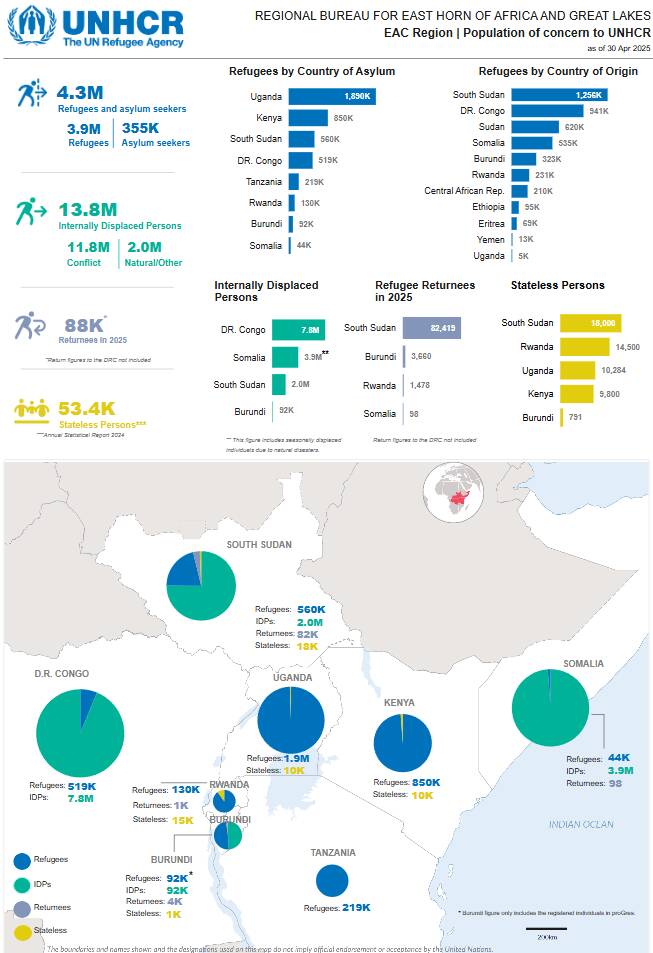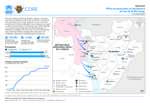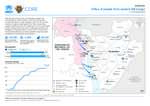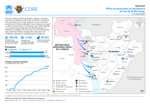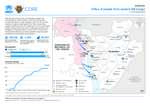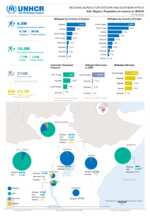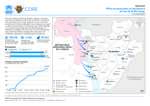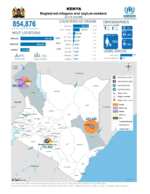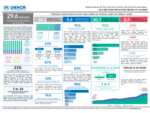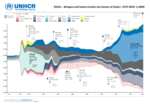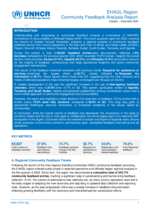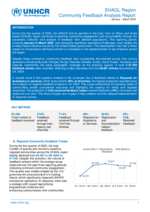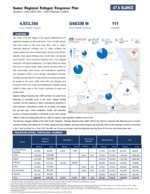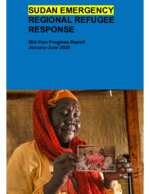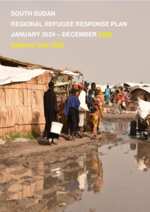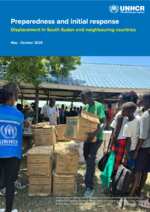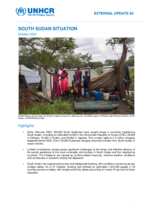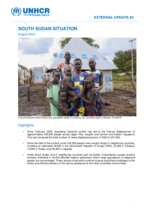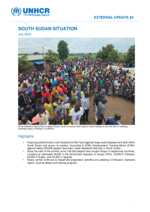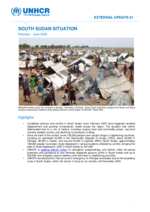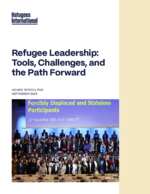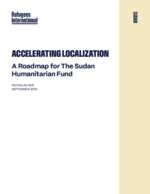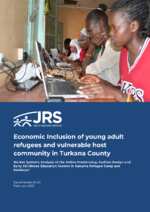JSON
Loading Total Refugees and Asylum-seekers in Kenya
| Country of origin | Source | Data date | Population | |
|---|---|---|---|---|
| Somalia | Government, UNHCR | 30 Nov 2025 | 53.3% | 338,431 |
| South Sudan | Government, UNHCR | 30 Nov 2025 | 31.9% | 202,712 |
| Dem. Rep. of the Congo | Government, UNHCR | 30 Nov 2025 | 6.9% | 43,621 |
| Ethiopia | Government, UNHCR | 30 Nov 2025 | 4.5% | 28,888 |
| Burundi | Government, UNHCR | 30 Nov 2025 | 1.6% | 10,207 |
| Sudan | Government, UNHCR | 30 Nov 2025 | 1.2% | 7,356 |
| Others | Government, UNHCR | 30 Nov 2025 | 0.5% | 2,941 |
| Uganda | Government, UNHCR | 30 Nov 2025 | 0.1% | 880 |
| Country of origin | Source | Data date | Population | |
|---|---|---|---|---|
| Somalia | Government, UNHCR | 30 Nov 2025 | 66.0% | 156,509 |
| Burundi | Government, UNHCR | 30 Nov 2025 | 10.3% | 24,425 |
| Dem. Rep. of the Congo | Government, UNHCR | 30 Nov 2025 | 9.4% | 22,348 |
| Ethiopia | Government, UNHCR | 30 Nov 2025 | 6.3% | 14,926 |
| Others | Government, UNHCR | 30 Nov 2025 | 3.9% | 9,359 |
| Sudan | Government, UNHCR | 30 Nov 2025 | 2.5% | 6,003 |
| Uganda | Government, UNHCR | 30 Nov 2025 | 1.4% | 3,406 |
| South Sudan | Government, UNHCR | 30 Nov 2025 | 0.0% | 97 |
| RAVES PROJECT - KENYA LAUNCH: Official launch of the Refugee Agricultural Value chains for Economic Self-reliance (RAVES) Programme. FAO with funding from the IKEA Foundation and in collaboration with the Turkana County Government, UNHCR, WFP, IFC, INSTA Products, Egerton University and other stakeholders has initiated a project aimed at enabling farmers from Loima and Turkana West Sub-Counties of Turkana County as well as refugees in Kalobeyei settlement to produce groundnut for INSTA Products in a Public Private Partnership. The four-year project is targeting 1,500 farmers, of which 30 percent are refugees, farming on approximately 750 acres and ultimately delivering 1,200 tons of Groundnuts per year. The project is expected to bring in KES 96 million annually to Turkana County and spur the development of a groundnut industry in the County. | |
| 29 Apr 2021 | |
| UNHCR in partnership with Oracle launched the Oracle Workforce Development program, which aims to impart digital skills training with global certifications. Five Persons of Concern (PoC (3 females, 2 males) from urban areas and eight PoC (3 females, 5 males) from Kakuma were shortlisted for the training after a competitive process. The trainees will be upskilled in Java Fundamental and Programming and later be linked to job opportunities. | |
| 30 Sep 2020 | |
| The National Council of Churches in Kenya (NCCK) donated medical equipment and Personal Protective Equipment (PPE) to UNHCR health partners in Kakuma to enhance the fight against COVID-19. The donation includes pulse oximeter, oxygen concentrators and cylinders, suction machines, infrared thermometers and assorted PPE. | |
| 30 Sep 2020 | |
| In August, UNHCR and implementing partners in Kakuma distributed 130,000 reusable facemasks donated by the Government of the United States. | |
| 30 Sep 2020 | |
| PoC who can no longer support themselves in urban areas continued to request for assistance to relocate to the camps. UNHCR and the Refugee Affairs Secretariat (RAS) worked on resuming PoC’s relocation to the camps. This had been suspended towards the end of August due to a high COVID-19 positivity rate among PoC that had been tested before travel. | |
| 30 Sep 2020 |
| Self-reliance and social networks: explaining refugees’ reluctance to relocate from Kakuma to Kalobeyei | |
| Self-reliance and social networks: explaining refugees’ reluctance to relocate from Kakuma to Kalobeyei | |
| UNHCR Kenya on Facebook | |
| . | |
| UNHCR Kenya on Instagram | |
| UNHCR Kenya on Twitter | |
| UNHCR Kenya Website | |
- Todos los documentos (1737)
- Actas de reuniones (16)
- Actualizaciones (7)
- Actualizaciones de situaciones (15)
- CORE (7)
- COVID-19 (1)
- Datos y estadísticas (732)
- Documentos 3RP (1)
- Documentos RRP Regionales (14)
- Documentos de estrategia (6)
- Evaluaciones (7)
- Financiamiento (31)
- Informes (19)
- Informes / Actualizaciones de Situación (265)
- Informes de Situación (8)
- Informes y documentos sobre políticas (5)
- Informes y evaluaciones (107)
- Mapas y datos geográficos (124)
- National Refugee Response Plans (3)
- Orientación (3)
- Panel de indicadores y hojas informativas (261)
- Perfiles de sitios (2)
- Planes de Respuesta regional (8)
- Términos de Referencia (TDR) (3)
- Sin categoría (168)
- Todos los documentos (1737)
- Actas de reuniones (16)
- Actualizaciones (7)
- Actualizaciones de situaciones (15)
- CORE (7)
- COVID-19 (1)
- Datos y estadísticas (732)
- Documentos 3RP (1)
- Documentos RRP Regionales (14)
- Documentos de estrategia (6)
- Evaluaciones (7)
- Financiamiento (31)
- Informes (19)
- Informes / Actualizaciones de Situación (265)
- Informes de Situación (8)
- Informes y documentos sobre políticas (5)
- Informes y evaluaciones (107)
- Mapas y datos geográficos (124)
- National Refugee Response Plans (3)
- Orientación (3)
- Panel de indicadores y hojas informativas (261)
- Perfiles de sitios (2)
- Planes de Respuesta regional (8)
- Términos de Referencia (TDR) (3)
- Sin categoría (168)
Afflux des personnes en provenance de la RDC - 23 décembre 2025
DocumentCreate date: 23 December 2025 (1 day ago)
Influx of people from DR Congo - 23 December 2025
DocumentCreate date: 23 December 2025 (1 day ago)
Afflux des personnes en provenance de la RDC - 21 décembre 2025
DocumentCreate date: 21 December 2025 (3 days ago)
Influx of people from DR Congo - 21 December 2025
DocumentCreate date: 21 December 2025 (3 days ago)
Regional Dashboard RBESA: Refugees, returnees and internally displaced persons in the EAC region - 30 November 2025
DocumentCreate date: 19 December 2025 (5 days ago)
Presentation - Kenya: Lessons from refugee inclusion in the National Hospital Insurance Fund (NHIF) - 05 April 2022
DocumentCreate date: 5 April 2022 (3 years ago)
Presentation - FAO : Latest developments on the drought situation in the region and FAO’s engagement in the displacement context - 31 March...
DocumentCreate date: 31 March 2022 (3 years ago)
Presentation - IFC Kenya: Creating Markets in Forced Displacement Contexts - 03 March 2022
DocumentCreate date: 9 March 2022 (3 years ago)
Presentation - UNHCR - Understanding financial inclusion and links to the global agenda - 01 April 2021
DocumentCreate date: 1 April 2021 (4 years ago)
Presentation - Legal and regulatory barriers to accessing connectivity and digital financial services in East Africa - 04 March 2021
DocumentCreate date: 15 March 2021 (4 years ago)
EHAGL - Regional Education Newsletter Q2 2024
DocumentCreate date: 29 August 2024 (1 year ago)
EHAGL Complementary Pathways Newsletter June 2023
DocumentCreate date: 3 November 2023 (2 years ago)
UNHCR EHAGL Operational Update April - June 2023
DocumentCreate date: 11 August 2023 (2 years ago)
UNHCR EHAGL Operational Update January - March 2023
DocumentCreate date: 23 May 2023 (2 years ago)
UNHCR EHAGL Operational Update October-December 2022
DocumentCreate date: 17 February 2023 (2 years ago)
Sudan Situation- UNHCR External Update #48 - 14 February 2024
DocumentCreate date: 15 February 2024 (1 year ago)
UNHCR Drought Situation Response Update No. 14 - September 2023
DocumentCreate date: 3 November 2023 (2 years ago)
Regional Climate Action Plan for the East and Horn of Africa and Great Lakes 2023-2028
DocumentCreate date: 1 November 2023 (2 years ago)
UNHCR Drought Situation Response Update #12 - July 2023
DocumentCreate date: 4 September 2023 (2 years ago)
UNHCR Drought Situation Response Update #11 - June 2023
DocumentCreate date: 28 July 2023 (2 years ago)
Afflux des personnes en provenance de la RDC - 23 décembre 2025
DocumentCreate date: 23 December 2025 (1 day ago)
Influx of people from DR Congo - 23 December 2025
DocumentCreate date: 23 December 2025 (1 day ago)
Afflux des personnes en provenance de la RDC - 21 décembre 2025
DocumentCreate date: 21 December 2025 (3 days ago)
Influx of people from DR Congo - 21 December 2025
DocumentCreate date: 21 December 2025 (3 days ago)
Afflux des personnes en provenance de la RDC - 19 décembre 2025
DocumentCreate date: 19 December 2025 (5 days ago)
WB - Socioeconomic Impacts of COVID-19 in Kenya - June 2021
DocumentCreate date: 13 July 2021 (4 years ago)
Kenya Statistics Infographics | June 2025
DocumentCreate date: 5 December 2025 (20 days ago)
Streamgraph: EHAGL | IGAD - Refugees and Asylum Seekers By Country of Origin | 1970 - 2024
DocumentCreate date: 24 June 2025 (6 months ago)
Kenya Statistics Infographics | May 2025
DocumentCreate date: 18 July 2022 (3 years ago)
RB EHAGL: 2024 - End year population trends at a glance
DocumentCreate date: 27 May 2025 (6 months ago)
Streamgraph: EHAGL - Refugees and Asylum Seekers By Country of Origin | 1970 - 2024
DocumentCreate date: 5 May 2025 (7 months ago)
Kenya Infographics 31March2023
DocumentCreate date: 18 April 2023 (2 years ago)
Kenya Mid Year Report - 2020 SSD RRRP
DocumentCreate date: 29 September 2020 (5 years ago)
South Sudan RRP – Kenya 2018 End Year Infographics
DocumentCreate date: 7 May 2019 (6 years ago)
South Sudan RRP – Kenya 2018 End Year Report
DocumentCreate date: 7 May 2019 (6 years ago)
2019-2020 Burundi Regional RRP - At a Glance Overview
DocumentCreate date: 21 December 2018 (7 years ago)
Burundi Regional Refugee Response Plan 2019-2020
DocumentCreate date: 21 December 2018 (7 years ago)
Financial Literacy Training-Minimum Standards July 2023
DocumentCreate date: 13 February 2025 (10 months ago)
CWG Harmonized Cash Approach Uganda 2024-2026
DocumentCreate date: 13 February 2025 (10 months ago)
Regional Bureau EHAGL: Multi Year Strategy ( 2025 - 2027)
DocumentCreate date: 19 July 2024 (1 year ago)
UNHCR KENYA - Livelihoods and Economic Inclusion Strategy 2020-2024
DocumentCreate date: 3 September 2021 (4 years ago)
UNHCR: East and Horn of Africa and Great Lakes - Stepped-up Livelihoods Strategic Directions 2021-2025
DocumentCreate date: 27 July 2021 (4 years ago)
Impact on the conflict in Sudan on onward and mixed movement
DocumentCreate date: 23 May 2024 (1 year ago)
IGAD - IGAD Regional Focus of the Global Report on Food Crises 2022 - In Brief
DocumentCreate date: 17 August 2022 (3 years ago)
IGAD - IGAD Regional Focus of the Global Report on Food Crises 2022 - Full Report
DocumentCreate date: 17 August 2022 (3 years ago)
IOM - WFP - Life amidst a Pandemic: Hunger, Migration and Displacement in the East and Horn of Africa - June 2021
DocumentCreate date: 9 July 2021 (4 years ago)
IGAD - 2021 Regional Report on Food Crises (RRFC) - Full Report
DocumentCreate date: 21 September 2021 (4 years ago)
RB-EHAGL: Critical Funding Needs - Horn of Africa Drought Situation Nov-Dec 2022
DocumentCreate date: 18 November 2022 (3 years ago)
NORTHERN ETHIOPIA EMERGENCY SITUATION UNHCR REGIONAL APPEAL JANUARY - DECEMBER 2022
DocumentCreate date: 16 March 2022 (3 years ago)
2018 South Sudan RRP Inter-Agency Funding Snapshot Dec 2018
DocumentCreate date: 16 January 2019 (6 years ago)
RRRP 2017 South Sudan Situation Mid Year Update Kenya at a glance
DocumentCreate date: 16 October 2017 (8 years ago)
RRRP 2017 South Sudan Situation Mid Year Update Regional level at a glance
DocumentCreate date: 16 October 2017 (8 years ago)
AAPGE Regional Workshop Report November 2023
DocumentCreate date: 23 December 2024 (1 year ago)
UNHCR EHAGL Region Gender Equality Promising Practices 2024
DocumentCreate date: 20 November 2025 (1 month ago)
EHAGL Region: Community Feedback Analysis Report. Oct - Dec 2024
DocumentCreate date: 9 July 2025 (5 months ago)
EHAGL Region: Community Feedback Analysis Report. Jan - Mar 2025
DocumentCreate date: 9 July 2025 (5 months ago)
CAPE TOWN OUTCOME DOCUMENT LEGAL SAFEGUARDS IN BIRTH REGISTRATION LAW FOR THE PREVENTION OF STATELESSNESS DEC 2023
DocumentCreate date: 4 July 2024 (1 year ago)
At-A-Glance - Sudan Regional Refugee Response Plan Mid-Year Progress Report (January - June 2025)
DocumentCreate date: 24 September 2025 (3 months ago)
At-A-Glance - Sudan Regional Refugee Response Plan: Mid-Year Progress Report (January - June 2025)
DocumentCreate date: 24 September 2025 (3 months ago)
Sudan Regional Refugee Response Plan: Mid-Year Progress Report (January - June 2025)
DocumentCreate date: 24 September 2025 (3 months ago)
South Sudan Regional Refugee Response Plan: January 2024 - December 2025
DocumentCreate date: 18 August 2025 (4 months ago)
South Sudan: Preparedness and initial Response needs, May – October 2025
DocumentCreate date: 16 June 2025 (6 months ago)
South Sudan Situation: UNHCR External Update #5 (October 2025)
DocumentCreate date: 28 November 2025 (26 days ago)
South Sudan Situation: UNHCR External Update #4 (September 2025)
DocumentCreate date: 27 October 2025 (1 month ago)
South Sudan Situation: UNHCR External Update #3 (August 2025)
DocumentCreate date: 2 October 2025 (2 months ago)
South Sudan Situation: UNHCR External Update #2 (July 2025)
DocumentCreate date: 28 August 2025 (3 months ago)
South Sudan Situation: UNHCR External Update #1 (February - June 2025)
DocumentCreate date: 11 August 2025 (4 months ago)
MoU of UNHCR Regional Office EHAGL and Population Council
DocumentCreate date: 2 June 2025 (6 months ago)
From Stateless to Citizens: the journey of the Shona community in Kenya
DocumentCreate date: 11 October 2024 (1 year ago)
Kenya: Refugee Policy Review Framework
DocumentCreate date: 13 March 2024 (1 year ago)
Nairobi declaration on Durable solutions for Somali refugees and reintegration of returnees in Somalia
DocumentCreate date: 28 June 2017 (8 years ago)
Culture, context and mental health of Somali refugees
DocumentCreate date: 5 January 2017 (8 years ago)
Refugees International - Refugee Leadership: Tools, Challenges, and the Path Forward - September 2025
DocumentCreate date: 2 October 2025 (2 months ago)
Refugees International - Accelerating Localization: A Roadmap for The Sudan Humanitarian Fund - September 2025
DocumentCreate date: 2 October 2025 (2 months ago)
JRS - Economic Inclusion of Refugees and Host Communities in Kenya: A market analysis
DocumentCreate date: 7 May 2025 (7 months ago)
Regional Intention Survey on South Sudanese Refugee Report - February 2025
DocumentCreate date: 18 February 2025 (10 months ago)
AAPGE Regional Workshop Report November 2023
DocumentCreate date: 23 December 2024 (1 year ago)
Burundi Situation Map - 31 December 2024
DocumentCreate date: 10 January 2025 (11 months ago)
Burundi Situation Map - 30 November 2024
DocumentCreate date: 17 December 2024 (1 year ago)
Burundi Situation Map - 31 October 2024
DocumentCreate date: 11 November 2024 (1 year ago)
Burundi Situation Map - 30 September 2024
DocumentCreate date: 15 October 2024 (1 year ago)
Burundi Situation Map - 31 August 2024
DocumentCreate date: 16 September 2024 (1 year ago)
Kenya Refugee Response Plan for South Sudanese 2019-2020
DocumentCreate date: 18 December 2018 (7 years ago)
South Sudan RRP – Kenya 2018 Mid-Year Infographics
DocumentCreate date: 1 October 2018 (7 years ago)
South Sudan RRP – Kenya 2018 Mid-Year Report
DocumentCreate date: 1 October 2018 (7 years ago)
UNHCR EHAGL Region Gender Equality Promising Practices 2024
DocumentCreate date: 20 November 2025 (1 month ago)
UNHABITAT and UNHCR - Settlement Profiling Tool, July 2020
DocumentCreate date: 27 November 2020 (5 years ago)
Guidance To Put Forward Sustainable Forestry Interventions In Displacement Settings In Kenya
DocumentCreate date: 3 November 2020 (5 years ago)
RB EHAGL: 2024 - End year population trends at a glance
DocumentCreate date: 27 May 2025 (6 months ago)
Afflux des personnes en provenance de la RDC - 23 décembre 2025
DocumentCreate date: 23 December 2025 (1 day ago)
Influx of people from DR Congo - 23 December 2025
DocumentCreate date: 23 December 2025 (1 day ago)
Afflux des personnes en provenance de la RDC - 21 décembre 2025
DocumentCreate date: 21 December 2025 (3 days ago)
Influx of people from DR Congo - 21 December 2025
DocumentCreate date: 21 December 2025 (3 days ago)
UNHABITAT and UNHCR - Settlement Profiling Tool, July 2020
DocumentCreate date: 27 November 2020 (5 years ago)
Ethiopia - Kebribeyah Settlement Profile, July 2020
DocumentCreate date: 27 November 2020 (5 years ago)
2023 Year-End Report for the South Sudan Regional Refugee Response Plan (RRRP)
DocumentCreate date: 31 December 2024 (11 months ago)
2022 Year End Report for the South Sudan Regional Refugee Response Plan (RRRP)
DocumentCreate date: 15 March 2024 (1 year ago)
2020 Year End Report for the South Sudan Regional Refugee Response Plan (RRRP)
DocumentCreate date: 13 August 2021 (4 years ago)
Executive summary of the outcomes of the regional Government-to-Government Conference, 31 October - 1 November 2019, Addis Ababa
DocumentCreate date: 16 December 2019 (6 years ago)
Outcome report on the outcomes of the regional Government-to-Government Conference, 31 October - 1 November 2019, Addis Ababa
DocumentCreate date: 16 December 2019 (6 years ago)
Youth Working Group (TOR)
DocumentCreate date: 19 August 2020 (5 years ago)
Community Based Protection Working Group (TOR)
DocumentCreate date: 19 August 2020 (5 years ago)
Mental Health and Psychosocial Support Working Group (TOR)
DocumentCreate date: 19 August 2020 (5 years ago)
UNHCR Kenya Operational Update, September 2020
DocumentCreate date: 19 November 2020 (5 years ago)
Kalobeyei Settlement Population Statistics 31 JANUARY 2019
DocumentCreate date: 4 February 2019 (6 years ago)
Kakuma Camp Population Statistics 31 JANUARY 2019
DocumentCreate date: 4 February 2019 (6 years ago)
UNHCR Dadaab bi-weekly update 01-15 March 2017
DocumentCreate date: 23 March 2017 (8 years ago)
UNHCR Dadaab bi-weekly update 15 - 28 Feb. 2017
DocumentCreate date: 13 March 2017 (8 years ago)
| Date of Funding Data | 30 March 2024 (1 year ago) |
-
Kenya Statistics Infographics | June 2025
Kenya Statistics Infographics as at 30 June 2025Publish date: 5 December 2025
-
Kenya - Eradication of Statelessness in the Eastern and Southern of Africa Region
Highlighting statelessness in the 12 Member States of the ICGLR, and what is being done to eradicate it. Media coverage, testimonies of stateless persons, reports on the issue and all documents pertaining to the Brazzaville Declaration process can be consulted in English, French, Portuguese and Arabic.
-
Kenya - DRC Situation
The on-going conflicts in the Democratic Republic of the Congo (DRC) have caused and continue to cause internal and external displacement of populations. In 2017, some 100,000 Congolese fled to neighbouring countries as refugees, due to widespread militia activities, unrest and violence, joining the 585,000 already in exile. The security conditions in DRC, especially in the eastern and central parts have continued to worsen since the beginning of 2018. Because of this, the Congolese refugee population is now among the ten largest in the world. Nearly 55 per cent are children, many crossing borders unaccompanied or separated. Existing camps and sites in many asylum countries are saturated, and available basic services are stretched to the limit. The situation requires support, adequate resources and collaboration so that effective protection and assistance can be delivered efficiently to Congolese refugees.
-
Kenya - South Sudan
As the protracted emergency enters its sixth year, the South Sudan situation remains the largest refugee situation on the African continent. There are over 2.2 million refugees in Sudan, Uganda, Ethiopia, Kenya and the Democratic Republic of the Congo and a further 1.8 million people displaced internally in South Sudan. The situation continues to be characterized as a children’s crisis with children constituting over 65 percent of the refugee population.
-
Kenya - Horn of Africa Somalia Situation
Somalia is at the heart of one of the worst humanitarian crises in the world today. Twenty years of conflict and waves of drought have uprooted a quarter of the country’s 7.5 million people. As the region faces its most severe drought in 60 years, the Somali exodus is growing fast. The refugees urgently need medical aid and high-protein, high-energy food. They also need clean water, shelter and basic services in the camps.
-
Kenya - Burundi Situation
Over 300,000 refugees have fled Burundi to the Democratic Republic of the Congo, Rwanda, Tanzania and Uganda since April 2015. The situation in Burundi remains complex; while refugees continue to arrive throughout the region, others are deciding to return home. The Burundi refugee response remains one of the most underfunding refugee situations in the world.
-
Kenya - Regional Bureau for Eastern and Southern Africa
UNHCR Regional Bureau for Eastern and Southern Africa (RBESA) is based in Nairobi, Kenya, covering 25 countries. This includes Angola, Botswana, Burundi, Comoros, Djibouti, Eritrea, Eswatini, Ethiopia, Kenya, Lesotho, Madagascar, Malawi, Mauritius, Mozambique, Namibia, Rwanda, Seychelles, Somalia, South Africa, South Sudan, Sudan, Tanzania, Uganda, Zambia, and Zimbabwe. This follows UNHCR’s restructuring in October 2025, merging countries previously under the East, Horn of Africa, and Great Lakes (EHAGL) and Southern Africa (SA) regional bureaus. In addition to the bureau, there are three Multi-Country Offices (MCO), Mozambique MCO that will be covering Mozambique and Angola, and Zambia MCO that will be covering Malawi, Zambia and Zimbabwe and South Africa MCO covering Botswana, Comoros, Eswatini, Lesotho, Madagascar, Mauritius, Namibia, Seychelles and South Africa. The bureau also manages two specific situations: the Sudan Situation and the South Sudan Situation. It is responsible for strategic decisions, regional priorities, integrity oversight, and quality assurance. The RBESA also provides technical support to country operations in various sectors, including education, child protection, economic inclusion, and durable solutions.
Microdata
Refugee Economies Programme
Kenya, Uganda, Ethiopia, 2018 MicroData View details | Get MicrodataAuthoring Entity: University of Oxford, Refugee Studies Centre
Published: 30 September 2024
Livelihoods Programme Monitoring Beneficiary Survey, 2023
Kenya, 2023 MicroData View details | Get MicrodataAuthoring Entity: UNHCR
Published: 12 December 2025
Livelihoods Programme Monitoring Beneficiary Survey, 2022
Kenya, 2022 MicroData View details | Get MicrodataAuthoring Entity: UNHCR
Published: 22 March 2024
Energy Monitoring Framework Survey, 2021
Kenya, 2021 MicroData View details | Get MicrodataAuthoring Entity: UNHCR
Published: 18 September 2022
Please contact the following focal points
| Type of Inquiry | Contact |
|---|---|
| Data management | Nancy Moraa matara@unhcr.org |
| Information Management | Ally Said saidal@unhcr.org |
